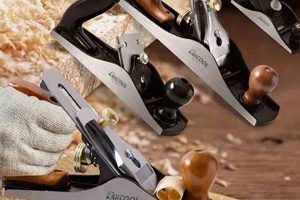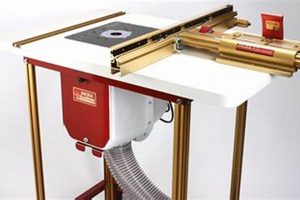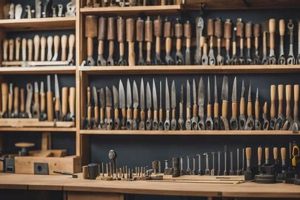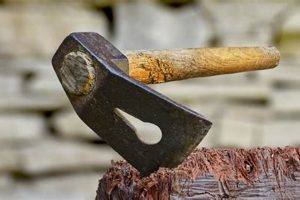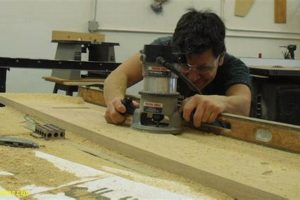The fundamental instruments required to initiate a woodworking venture encompass a range of equipment necessary for cutting, shaping, joining, and finishing wood. This includes items such as a table saw for accurate cuts, a jointer and planer for preparing lumber, a drill press for precise drilling, and various hand tools like chisels and saws for detailed work. The specific selection of equipment will depend on the nature and scale of the planned business operations.
Possessing the right equipment is paramount for efficiency, precision, and safety in woodworking. Investing in quality tools from the outset can minimize material waste, enhance the quality of the finished product, and reduce the risk of workplace injuries. Historically, woodworking relied heavily on manual tools, but the advent of power tools has significantly increased productivity and expanded the possibilities for complex designs.
Establishing a functional woodworking business necessitates careful consideration of the core equipment categories, encompassing cutting, shaping, joining, and finishing processes. A comprehensive understanding of the options available within each category allows for informed purchasing decisions that align with the business’s specific production goals and budgetary constraints. This selection forms the foundation upon which the woodworking business will build its reputation and achieve its operational objectives.
Essential Equipment Selection Guidelines
The following recommendations serve as a guide to optimize the acquisition of core equipment for a nascent woodworking enterprise. Prioritize tools based on anticipated project demands and resource availability.
Tip 1: Assess Project Requirements. Prior to any purchases, thoroughly analyze the types of projects the business intends to undertake. This assessment will determine the necessary tool capabilities and scale, preventing overspending on unnecessary equipment.
Tip 2: Prioritize Safety Features. Integrating equipment with advanced safety mechanisms is crucial. Features such as blade guards, dust collection systems, and emergency stop controls mitigate risks and promote a safer working environment.
Tip 3: Begin with Core Tools. Concentrate on acquiring fundamental equipment first, such as a quality table saw, jointer, planer, and a selection of essential hand tools. Subsequent investments should be guided by business growth and evolving project needs.
Tip 4: Research Reputable Brands. Thoroughly investigate equipment manufacturers’ reputations for reliability, durability, and customer support. Investing in established brands generally yields a higher return on investment in the long term.
Tip 5: Consider Used Equipment. Purchasing used equipment can significantly reduce initial costs. However, ensure a comprehensive inspection is performed by a qualified technician to verify functionality and safety.
Tip 6: Invest in Dust Collection. An effective dust collection system is essential for maintaining air quality and ensuring a clean working environment. This impacts both worker health and the quality of the final product.
Tip 7: Implement a Maintenance Schedule. Regular maintenance is critical for extending the lifespan and optimizing the performance of all woodworking equipment. This includes cleaning, lubrication, and timely replacement of worn parts.
Strategic equipment selection is a cornerstone of a successful woodworking venture. Prudent investments in quality tools, coupled with rigorous safety protocols and consistent maintenance, contribute significantly to long-term profitability and operational sustainability.
The selection of equipment represents only the initial phase of establishing a woodworking business. Comprehensive planning, skilled craftsmanship, and effective marketing strategies are also vital for achieving sustained success in this competitive field.
1. Cutting Equipment
The selection of cutting equipment constitutes a fundamental aspect of the tools necessary to establish a woodworking business. The capacity to efficiently and accurately process raw materials directly influences the range of projects the business can undertake. Inadequate cutting capabilities inherently limit the scope and complexity of potential offerings, potentially impacting profitability and market competitiveness. For instance, a business specializing in custom cabinetry requires a high-precision table saw and a band saw capable of intricate curved cuts, while a business focused on simpler millwork might prioritize a robust circular saw and miter saw.
Investing in appropriate cutting equipment impacts both the speed and quality of production. A well-maintained table saw with a sharp blade ensures clean, square cuts, minimizing material waste and reducing the need for post-processing. Similarly, a band saw with variable speed settings enables efficient cutting of diverse materials, from hardwoods to non-ferrous metals. Furthermore, specialized cutting tools like jigsaws and routers, when equipped with appropriate bits, facilitate the creation of complex shapes and profiles, expanding design possibilities and increasing the perceived value of the finished product. Without suitable cutting equipment, a woodworking business risks compromising project timelines and quality standards.
The strategic selection of cutting equipment directly determines the operational capabilities and financial viability of a woodworking enterprise. A comprehensive understanding of the available options, coupled with a realistic assessment of project requirements, is essential for making informed purchasing decisions. Prioritizing quality and versatility in cutting tools represents a critical investment that underpins the business’s ability to deliver high-quality products efficiently and consistently, thereby fostering customer satisfaction and long-term growth.
2. Shaping Tools
Shaping tools are indispensable components within the spectrum of equipment necessary for commencing a woodworking enterprise. The capacity to manipulate and refine raw lumber into precise forms is critical for producing high-quality, aesthetically pleasing products. These tools enable woodworkers to achieve dimensional accuracy, smooth surfaces, and intricate designs, directly influencing the market value and customer satisfaction associated with their creations.
- Jointer Functionality
A jointer establishes a flat, true reference surface on lumber, essential for subsequent machining operations. This machine precisely flattens one face and one edge of a board, providing a stable base for planing and other processes. Without a properly jointed reference surface, achieving accurate dimensions and squareness in finished products becomes exceedingly difficult, potentially resulting in structural instability and visual imperfections.
- Planer Application
A planer reduces lumber to a consistent thickness and creates parallel surfaces. This tool ensures uniformity across multiple pieces of wood, crucial for assembling cabinets, furniture, and other complex structures. Planers contribute significantly to efficiency by eliminating manual sanding and reducing material waste, particularly when working with expensive hardwoods.
- Router Versatility
A router, equipped with various bits, performs a multitude of shaping tasks, including edge profiling, creating grooves, and cutting intricate designs. This tool allows for customization and decorative embellishments, enabling woodworkers to differentiate their products and cater to specific client preferences. Routers are particularly valuable for crafting moldings, trim, and decorative panels.
- Spindle Sander Utility
Spindle sanders refine curved edges and internal contours, smoothing out imperfections and preparing surfaces for finishing. This tool is essential for creating seamless transitions between different components and achieving a professional-grade finish on contoured parts. The oscillating spindle action minimizes sanding marks and ensures uniform material removal.
The integration of shaping tools into a woodworking business’s equipment arsenal allows for the efficient and precise transformation of raw materials into refined, marketable products. Prudent investment in quality shaping equipment, coupled with skilled operation, contributes directly to the business’s ability to meet customer expectations, maintain competitive pricing, and achieve sustainable profitability.
3. Joining Instruments
The instruments employed for joining wood components represent a critical facet of the equipment required to initiate a woodworking enterprise. The structural integrity and aesthetic appeal of finished products are directly contingent upon the effectiveness of the joining techniques and the quality of the associated tools. Selecting appropriate joining instruments is therefore a fundamental consideration when planning a woodworking venture.
- Clamps and Workholding
Clamps and workholding devices are essential for securing wood pieces during gluing and assembly processes. Various types, including bar clamps, pipe clamps, and spring clamps, provide the necessary pressure to create strong, seamless joints. For example, constructing a solid wood table requires multiple bar clamps to ensure even pressure distribution along the glue lines, preventing warping or gaps. Inadequate clamping can result in weak joints, jeopardizing the structural integrity and longevity of the finished product.
- Fastening Systems: Screws and Nails
Screws and nails serve as mechanical fasteners, providing additional strength and stability to wood joints. The selection of appropriate screw and nail types, along with the corresponding driving tools, is crucial for achieving secure and aesthetically pleasing connections. For instance, using countersunk screws to fasten cabinet frames allows for a flush surface that can be easily concealed with wood filler. Conversely, using the wrong type of nail gun can lead to splitting or damage to the wood, resulting in a substandard finish.
- Joinery Tools: Mortise and Tenon
For projects requiring exceptional strength and durability, joinery techniques such as mortise and tenon joints are often employed. Specialized tools, including mortise chisels, tenon saws, and mortising machines, facilitate the creation of precise and interlocking components. For instance, constructing a sturdy chair or table often involves mortise and tenon joints at critical stress points. The precision achieved with these tools directly impacts the joint’s load-bearing capacity and overall structural soundness.
- Adhesives and Glue Application
Wood adhesives play a critical role in creating durable and long-lasting joints. The correct application of glue, using brushes, rollers, or specialized glue spreaders, ensures optimal bonding strength. For example, when laminating multiple layers of wood to create a curved component, uniform glue distribution is essential to prevent delamination. The choice of adhesive, whether it be PVA glue, epoxy, or polyurethane glue, depends on the specific wood species, joint type, and environmental conditions.
The selection and proper utilization of joining instruments are inextricably linked to the success of a woodworking business. Prioritizing quality tools and mastering various joining techniques enables the production of durable, aesthetically pleasing, and structurally sound products, enhancing customer satisfaction and establishing a strong reputation within the woodworking industry. The instruments, therefore, form an integral component of the initial investment in a woodworking enterprise.
4. Finishing Supplies
The selection of finishing supplies forms an integral and necessary component of the tools required to establish a woodworking business. These supplies, while not directly involved in the physical manipulation of wood, profoundly impact the final product’s aesthetic appeal, durability, and market value. Inadequate investment in appropriate finishing supplies can negate the value of skilled craftsmanship and high-quality materials used in earlier stages of production. For example, a meticulously constructed piece of furniture utilizing premium hardwoods can be rendered aesthetically unappealing and susceptible to damage if finished with a substandard or improperly applied coating.
The types of finishes employed dictate not only the visual characteristics of the wood but also its resistance to environmental factors such as moisture, UV radiation, and abrasion. Varnishes, lacquers, polyurethanes, and oils each offer distinct levels of protection and aesthetic qualities, and their selection must align with the intended use and environment of the finished product. Furthermore, preparatory materials like sandpaper, wood fillers, and stains play a crucial role in achieving a smooth, uniform surface that enhances the adhesion and performance of the final coating. The application of these supplies often necessitates specialized tools such as spray guns, brushes, and sanding equipment, further emphasizing their interconnectedness with the overall tool requirements of a woodworking business.
Therefore, a comprehensive understanding of finishing techniques and the corresponding supplies is paramount for any woodworking business aiming to produce high-quality, commercially viable products. The selection of appropriate finishes and their proper application directly influence the longevity, aesthetic appeal, and ultimate value of the finished work. Insufficient attention to this critical aspect of woodworking can result in diminished product quality, reduced customer satisfaction, and ultimately, compromised business success. Investing in quality finishing supplies and mastering their application is therefore an essential element of establishing a successful woodworking enterprise.
5. Safety Gear
Safety gear is not merely an ancillary consideration but a fundamental component inextricably linked to the equipment required to initiate a woodworking business. The inherent risks associated with woodworking machinery and processes necessitate the inclusion of appropriate protective measures to mitigate potential injuries and ensure a safe working environment. Prioritizing safety contributes directly to employee well-being, reduces potential liabilities, and safeguards the long-term viability of the business.
- Eye Protection: Shielding Against Projectiles
The use of safety glasses or face shields is paramount in woodworking environments due to the constant presence of airborne particles and projectiles. Sawdust, wood chips, and fragments from cutting or shaping operations can pose significant risks to eye health and vision. For instance, operating a router without proper eye protection can result in high-speed debris impacting the cornea, leading to severe injury or permanent vision impairment. The implementation of mandatory eye protection protocols is therefore an essential aspect of any responsible woodworking business.
- Hearing Protection: Mitigating Noise-Induced Damage
Woodworking machinery often generates high decibel levels that, over prolonged exposure, can lead to irreversible hearing damage. Devices such as earplugs or earmuffs serve to attenuate these noise levels, protecting workers’ auditory systems from harm. Regularly operating a planer or table saw without adequate hearing protection can result in gradual hearing loss and tinnitus, negatively impacting quality of life and potentially hindering job performance. Providing and enforcing the use of hearing protection is a crucial responsibility for woodworking business owners.
- Respiratory Protection: Safeguarding Against Airborne Hazards
Wood dust, a common byproduct of woodworking processes, presents a significant respiratory hazard. Inhalation of fine wood dust particles can lead to respiratory irritation, allergic reactions, and even chronic lung diseases. Dust masks or respirators provide a barrier against these airborne contaminants, safeguarding workers’ respiratory health. Sanding operations, in particular, generate substantial amounts of fine dust, necessitating the use of appropriate respiratory protection to prevent long-term health complications.
- Protective Clothing: Minimizing Skin Injuries
Appropriate protective clothing, such as work aprons and gloves, helps to minimize the risk of cuts, abrasions, and other skin injuries associated with handling woodworking tools and materials. Work aprons provide a barrier against sharp objects and splinters, while gloves protect hands from cuts and abrasions when handling rough lumber or sharp tools. Selecting durable, well-fitting protective clothing is essential for ensuring worker comfort and safety.
The selection and provision of appropriate safety gear are indispensable components of the equipment list for establishing a woodworking business. Integrating these measures not only protects workers from potential harm but also contributes to a more productive and sustainable work environment. A commitment to safety reflects a responsible business ethos and safeguards against potential liabilities, ultimately contributing to the long-term success of the woodworking enterprise.
Frequently Asked Questions
The following addresses prevalent inquiries regarding the essential tools necessary for establishing a woodworking business. Clear and accurate information is crucial for informed decision-making in this context.
Question 1: What constitutes the absolute minimum toolset for initiating a basic woodworking business?
A foundational toolset includes a table saw, jointer, planer, drill press, miter saw, a selection of hand planes and chisels, and various measuring and marking tools. This configuration enables fundamental wood processing and fabrication tasks.
Question 2: Is it financially prudent to invest in new or used equipment at the outset?
The decision to acquire new or used equipment is contingent upon budgetary constraints and the specific tool in question. Core equipment, such as a table saw, may warrant a new purchase for reliability and warranty coverage. Conversely, certain auxiliary tools could be acquired used, provided they undergo thorough inspection.
Question 3: To what extent does the scale of the intended business operations influence tool selection?
The scope of business operations directly impacts equipment requirements. A small-scale, specialty woodworking venture may necessitate specialized hand tools and smaller machinery. Conversely, a large-scale production facility demands robust, high-volume equipment capable of sustained operation.
Question 4: What role does dust collection play in the context of woodworking equipment?
An effective dust collection system is not optional but integral to maintaining a safe and compliant woodworking environment. Fine wood dust poses significant respiratory hazards, necessitating the implementation of a robust dust collection system to mitigate health risks.
Question 5: How frequently should woodworking equipment undergo maintenance and calibration?
Woodworking equipment should adhere to a regular maintenance schedule, encompassing cleaning, lubrication, and component inspection. Calibration, particularly for precision machinery such as table saws and jointers, is crucial for maintaining accuracy and safety.
Question 6: Are there specific safety certifications or training requirements associated with operating woodworking equipment?
Operating woodworking equipment necessitates a thorough understanding of safety protocols and procedures. Formal training courses and adherence to manufacturer guidelines are essential for minimizing the risk of accidents and injuries. Furthermore, compliance with relevant regulatory standards is paramount.
Effective tool selection and prudent investment are cornerstones of a successful woodworking business. Prioritizing safety, efficiency, and versatility is crucial for achieving long-term viability.
The subsequent discussion will address the specific equipment needs associated with various woodworking specializations.
Conclusion
The comprehensive evaluation of equipment underscores that determining “what tools do i need to start a woodworking business” involves careful consideration of cutting, shaping, joining, and finishing capabilities, as well as unwavering adherence to safety protocols. The initial investment in quality tools, appropriate for the scale and specialization of the business, directly impacts operational efficiency, product quality, and ultimately, profitability.
Successful navigation of the woodworking landscape necessitates a strategic approach to equipment acquisition, ongoing maintenance, and a commitment to continuous improvement. The long-term viability of the enterprise hinges on the ability to adapt to evolving market demands, embrace technological advancements, and consistently deliver exceptional craftsmanship. Therefore, the informed selection of tools represents not merely a purchase, but an investment in the future success and sustainability of the woodworking business.


